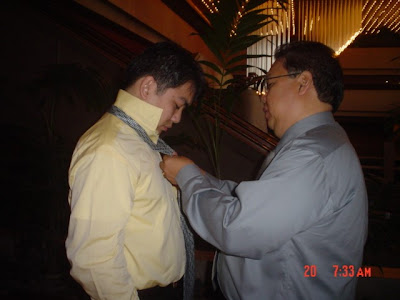We just ended Day 2 of our 7-day course on disaster management held at the Fakultas Kedokteran Universitas Indonesia (FKUI); I know I need not translate. Main proponents of the course aside from FKUI are the Spanish International Aid Agency, the University of Oviedo – Unit for Research on Emergencies and Disasters, the Office of the Surgeon General – Indonesia and various other Indonesian and Spanish government and non-government agencies. Twenty-five participants from Indonesia, Malaysia, the Philippines, Sri Lanka and Vietnam involved in the different aspects of disaster management and emergency preparedness in our respective countries. The main facilitator is Dr. Bastaman Basuki of the Department of Community Medicine, FKUI
The Philippine contingent is composed of myself representing the UP and a non-government organization Gawad Kalusugan; Dr. Rex Prudente and Dr Rolly Rivera from the V. Luna Medical Center and Office of the Surgeon General, respectively; Dr. Chito Mendoza, Provincial Health Officer of Albay and one of his staff in the PHO, Ms. Elvie Alejo, RN; Dr. Joey Abary from the Bureau of Fire Protection; Dr. Sally Espeleta from the Department of Health – National Capital Region; and Dr. Des Jimenez, Chief Resident of the Department of Emergency Medicine, UP-PGH.

In the photo above at the lobby of the Sari Pan Pacific Jakarta Hotel where we’re staying:
Dr. Rex, Dr. Sally, Dr. Rolly, Dr. Chito, Dr. Des, Maam Elvie, and Dr. Joey.
There are four Spanish resource persons and about a dozen Indonesian experts whose depth and breadth of experience come from stints in Sarajevo to Sumatra to Southern Leyte, dealing with earthquakes, wars, and yes, tsunamis. What we’ve covered so far are general trends and patterns in disaster management statistics (deaths and injuries according to disaster types), the learnings of Spain from its current emergency medical system, and the learnings of Indonesia from the 2 Bali bombings, the last Yogyakarta earthquake, the 2007 Jakarta floods, and the 2004 tsunami which hit Aceh. There were special segments detailing the role of the Indonesian military in the delivery of much needed assistance during the critical period following the disasters, including its presence in Guinsaugon, Southern Leyte.
In the photos below: Dr Arcos delivering his lecture; with participants from Malaysia, Indonesia, the Philippines, and Vietnam.


I asked Dr. Pedro Arcos of the University of Oviedo – Unit for Research on Emergencies and Disasters, one of the resource persons from Spain, how extensive their disaster management course was in their medical school. He said that disaster management occupied one week in their six-year curriculum for poly-health professionals. I told him that disaster management as a separate lecture was an innovation in the UP College of Medicine and I was lamenting the fact that we only had 2 hours for the topic, versus his one week. To which he responded that it took twenty years for them to include disaster management in their curriculum. I am both grateful and optimistic: In my capacity as a teacher, it is heartening to note that what we’re imparting in the university to third year medical students in the form of a two-hour lecture over the last academic year is a rather nice distillation of what we’ve taken up since Monday.

My interactions with my fellow Filipino delegates are a source of immense joy as well. From where they are coming from, I am learning much about the disaster management situation in our country, outside of the official National Disaster Coordinating Council annual reports online. One cannot help but feel something warm and fuzzy as they detail their extended hours doing orthopedic surgeries for war vicitims, wading in waist-high waters in Legazpi City, tours of duty with firefighters sans decent pay, the continuous efforts to update tertiary hospital care in the Philippines in anticipation of imminent disasters in our country since we are embroiled in unending socio-political strife; we are blessed with 22 active volcanoes; we are residing over restless tectonic plates; and we are the doormat of typhoons entering Asia from the Pacific and leaving Asia from the South China Sea.
Hopefully, I’ll get more ideas on how to establish a community-based disaster management program for urban and rural poor communities, the most vulnerable and at risk when calamities strike. As of late, the facilitators have focused on the macro level of governance and action with rather little time allotted for community empowerment strategies. Hopefully, as well, Cooperacion Espanola will choose the Philippines as a pilot site for a multi-center disaster management program they are setting up in Asia. Fingers, legs, and eyes crossed!
--==+==--
If ever I would experience The Twilight Zone, it would be now, in Jakarta.

It’s Manila’s twin city, replete with hordes of motorcycles, Starbucks branches, shanties propped against the walls of gated communities, enterprising sidewalk vendors, San Miguel and Chippy in the supermarket and very Filipino-looking fellow human beings. As an exclamation point to this observation, the bus which was transporting us from the seminar venue to our hotel suddenly stopped because a public utility vehicle made a sudden U-turn and narrowly missed hitting us (or being hit by us!). I thought to myself- Wow, Indonesians do know how to make one feel welcome, even simulating the prayer-inducing driving techniques of Pinoys…



















 Indonesia exudes charm unimaginable that no culturati can resist. It has a mix of the old and the new, the modern and the mystical. In so many aspects it is so much like the Philippines, in some aspects it does appear to fare better. Nevertheless, I am glad- SO GLAD- to be home.
Indonesia exudes charm unimaginable that no culturati can resist. It has a mix of the old and the new, the modern and the mystical. In so many aspects it is so much like the Philippines, in some aspects it does appear to fare better. Nevertheless, I am glad- SO GLAD- to be home.








